Envisioning Digital Practices in the Metaverse: A Methodological Perspective †
Abstract
:1. Introduction
2. Motivation
- Research Objectives
3. Analysis of the Domain through Social Practices
3.1. Social Practices
- Context: Describing the physical aspect of the environment, it includes the Resources used in the practice, the involved Actors, Affordances enabling social actions, the Time during which the practice occurs, and Places where objects and actors are typically situated.
- Meaning: Encompassing the Purpose of actions, Promotes values supported by the Practice, and Counts-as rules, which denote the interpretation of facts within the context.
- Expectations: Within the practice, these involve potential Plan Patterns, Norms, Strategies), as well as Start and End conditions for the practice.
- Activities: Encompassing the Competences that an agent needs to possess and Possible Actions that can be performed within the practice.
3.2. Identifying Social Practices
4. Designing and Coordinating Digital Entities
4.1. Digital Twins
4.2. Digital Practice
- A set of Roles for human and software agents. In particular, humans are stakeholders, whereas agents are responsible for enacting autonomous and proactive behaviours within the practice (e.g., virtual assistants).
- Context: Digital twins are central for representing entities of the physical setting (humans, resources and spaces); they are used to define the activation rule of the practice, i.e., the specific situation in which the practice activates.
- Time and Space: Essential to delineate the practice’s activation rule.
- Domain Knowledge: Allows disambiguating the meaning in the practice; it is typically represented as a set of beliefs and rules concerning a domain of interest, allowing the software system to perform automatic reasoning and pattern matching.
- A Goal Model: It represents the final purpose of the practice, merging meaning and social expectation (the feeling that something will or should happen in a context); it includes goals and soft goals linked together by relationships. Goals represent states of the world to be addressed, whereas soft goals represent qualities and values the practice promotes.
- A set of Capabilities: What the digital entities can do (are expected to) do in the digital practice.
- Digital Affordances: Expressing ways of conveying to end-users what actions are possible in the context and how to interact with the system.
- An Orchestration Plan: It describes a usual flow of actions to address the final purpose. This is not necessarily a static plan.
- Norms/Conditions: They hold in the social setting and describe what is considered acceptable and not.
4.3. Agents and Intelligent NPCs
5. Implementation Phase
- The virtual environment will be developed by using the Unity framework and official libraries (like Barracuda).
- We selected JaCaMo [19] as the common platform for agent-based applications. JaCaMo includes
- Even if not mandatory, we suggest the WLDT library [38] for speeding up the definition of digital twins.
- Mapping Digital Practices into the Architecture
6. A Case Study
6.1. Identifying the Social Practices for the Grocery Shop
- Physical: Customers and employees physically present in the grocery shop.
- Virtual: Avatar of remote customers or employees in the grocery shop.
- Customers: Digital or real users purchasing food and/or other household items.
- Employees: Digital or real users assisting customers and maintaining the store.
- NPC agents have the role of providing support.
- Physical: The products in the store, shopping carts or baskets, cash registers, and other tools or equipment used to maintain the store.
- Virtual: Virtual representations of products, shopping carts or baskets, and other tools or equipment used to navigate and interact within the virtual environment.
- The main places are the grocery shop and its virtual representation in the metaverse.
- Both the physical and virtual shop may be specific areas such as aisles, checkout lanes, and customer service desks where interactions between customers and employees are more likely to occur.
- The store layout might make it easy for customers to find employees when they need help or to interact with items.
- Signage and other visual cues might also help guide customers to areas where they can interact with employees.
- The time aspect of this context might include the hours of operation of the grocery shop and any peak times when the store is particularly busy.
- The length of time customers spend in the store and the frequency of their visits might also be relevant.
- Physical and Virtual: Receiving help finding an item, asking a question about a product, providing feedback, or making a complaint.
- Only Virtual: Providing feedback on the virtual shopping experience or participating in interactive experiences.
- Physical and Virtual: The values promoted by this social practice include helpfulness, politeness, and respect. For example, customers might value knowledgeable employees willing to help them find their needs. Employees might value customers who treat them with respect and follow the store’s policies.
- If the purpose is for a customer to receive help finding an item. In that case, a successful interaction might involve the employee providing clear and accurate information about where to find the item.
- If the purpose is for a customer to make a complaint, then a successful interaction might involve the employee listening attentively and taking appropriate action to address the issue.
- Physical and Virtual: If a customer needs help finding an item, the plan pattern might involve the customer approaching an employee and asking for help. The employee might then provide information or guide the customer to the item’s location.
- Virtual: Using virtual assistants to request help or to find an employee.
- Customers are expected to treat employees respectfully and follow the store’s policies.
- Employees are expected to provide helpful and polite service to customers.
- The interaction might begin when a customer approaches an employee and asks for help or when an employee greets a customer as they enter the store.
- Some interactions might be brief, such as when a customer asks for directions to a particular item. Other interactions, such as when a customer has a complex question or complaint, might be longer.
- The interaction might end when the customer’s question has been answered or their issue has been resolved. Alternatively, the interaction might end when the customer leaves or moves to another store area.
- Physical and virtual: Asking for help finding an item, making a complaint, providing feedback, or simply engaging in small talk while checking out.
- Only Physical: Other possible actions include employees restocking shelves, assisting customers with self-checkout machines, or helping customers bag their items.
- Only Virtual: Using virtual tools or menus to request assistance, participating in interactive experiences or games, and providing feedback on the virtual shopping experience.
- Good communication skills, knowledge of the store’s products and layout, and the ability to handle customer complaints or issues professionally.
- Customers also need the ability to navigate the store and locate items independently.
6.2. Implementing the Virtual Grocery Shop
- Virtual assistant (or personal agents) sensing and acting in the environment, providing services and interacting with humans or other agents in the environment;
- Digital-twin-manager agents, in charge of encapsulating the autonomy and proactivity of some complex digital twins; these agents respond to the need to have a clear separation of concerns (as clearly discussed in [36], where digital twins are used to mirroring some aspects of physical things, whereas business logic, reasoning, and in general intelligent and proactive behaviour are more pronounced for an agent;
- Digital-practice-agents that are in charge of ensuring the activation and fulfilment of digital practices.
7. Conclusions and Future Works
Author Contributions
Funding
Data Availability Statement
Conflicts of Interest
References
- Deloitte Research and Analysis. The Metaverse Overview: Vision, Technology, and Tactics. Available online: https://www2.deloitte.com/cn/en/pages/technology-media-and-telecommunications/articles/metaverse-report.html (accessed on 1 December 2023).
- Hutson, J. Social Virtual Reality: Neurodivergence and Inclusivity in the Metaverse. Societies 2022, 12, 102. [Google Scholar] [CrossRef]
- Mourtzis, D.; Panopoulos, N.; Angelopoulos, J.; Wang, B.; Wang, L. Human centric platforms for personalized value creation in metaverse. J. Manuf. Syst. 2022, 65, 653–659. [Google Scholar] [CrossRef]
- Brettel, M.; Friederichsen, N.; Keller, M.; Rosenberg, M. How virtualization, decentralization and network building change the manufacturing landscape: An Industry 4.0 Perspective. Int. J. Inf. Commun. Eng. 2014, 8, 37–44. [Google Scholar]
- Glaessgen, E.; Stargel, D. The digital twin paradigm for future NASA and US Air Force vehicles. In Proceedings of the 53rd AIAA/ASME/ASCE/AHS/ASC Structures, Structural Dynamics and Materials Conference 20th AIAA/ASME/AHS Adaptive Structures Conference 14th AIAA, Honolulu, HI, USA, 23–26 April 2012; p. 1818. [Google Scholar]
- Saracco, R. Digital twins: Bridging physical space and cyberspace. Computer 2019, 52, 58–64. [Google Scholar] [CrossRef]
- Fuller, A.; Fan, Z.; Day, C.; Barlow, C. Digital twin: Enabling technologies, challenges and open research. IEEE Access 2020, 8, 108952–108971. [Google Scholar] [CrossRef]
- Tekinerdogan, B. On the Notion of Digital Twins: A Modeling Perspective. Systems 2023, 11, 15. [Google Scholar] [CrossRef]
- VanDerHorn, E.; Mahadevan, S. Digital Twin: Generalization, characterization and implementation. Decis. Support Syst. 2021, 145, 113524. [Google Scholar] [CrossRef]
- Dwivedi, Y.K.; Hughes, L.; Baabdullah, A.M.; Ribeiro-Navarrete, S.; Giannakis, M.; Al-Debei, M.M.; Dennehy, D.; Metri, B.; Buhalis, D.; Cheung, C.M.; et al. Metaverse beyond the hype: Multidisciplinary perspectives on emerging challenges, opportunities, and agenda for research, practice and policy. Int. J. Inf. Manag. 2022, 66, 102542. [Google Scholar] [CrossRef]
- Freeman, G.; Acena, D. Hugging from A Distance: Building Interpersonal Relationships in Social Virtual Reality. In Proceedings of the ACM International Conference on Interactive Media Experiences, Virtual, 21–23 June 2021; pp. 84–95. [Google Scholar]
- Reckwitz, A. Toward a theory of social practices: A development in culturalist theorizing. Eur. J. Soc. Theory 2002, 5, 243–263. [Google Scholar] [CrossRef]
- Holtz, G. Generating social practices. J. Artif. Soc. Soc. Simul. 2014, 17, 17. [Google Scholar] [CrossRef]
- Augello, A. Unveiling the reasoning processes of robots through introspective dialogues in a storytelling system: A study on the elicited empathy. Cogn. Syst. Res. 2022, 73, 12–20. [Google Scholar] [CrossRef]
- Dignum, F. Social Practices: A Complete Formalization. arXiv 2022, arXiv:2206.06088. [Google Scholar]
- Gatto, L.; Fulvio Gaglio, G.; Augello, A.; Caggianese, G.; Gallo, L.; La Cascia, M. MET-iquette: Enabling virtual agents to have a social compliant behavior in the Metaverse. In Proceedings of the 2022 16th International Conference on Signal-Image Technology & Internet-Based Systems (SITIS), Dijon, France, 19–21 October 2022; pp. 394–401. [Google Scholar] [CrossRef]
- Liang, H.; Li, J.; Wang, Y.; Pan, J.; Zhang, Y.; Dong, X. Metaverse virtual social center for the elderly communication during the social distancing. Virtual Real. Intell. Hardw. 2023, 5, 68–80. [Google Scholar] [CrossRef]
- Georgeff, M.; Pell, B.; Pollack, M.; Tambe, M.; Wooldridge, M. The belief-desire-intention model of agency. In Proceedings of the Intelligent Agents V: Agents Theories, Architectures, and Languages: 5th International Workshop, ATAL’98, Paris, France, 4–7 July 1998; Proceedings 5. Springer: Berlin/Heidelberg, Germany, 1999; pp. 1–10. [Google Scholar]
- Boissier, O.; Bordini, R.H.; Hübner, J.F.; Ricci, A.; Santi, A. Multi-agent oriented programming with JaCaMo. Sci. Comput. Program. 2013, 78, 747–761. [Google Scholar] [CrossRef]
- Dignum, V.; Dignum, F. Contextualized planning using social practices. In Proceedings of the Coordination, Organizations, Institutions, and Norms in Agent Systems X: COIN 2014 International Workshops, COIN@ AAMAS, Paris, France, 6 May 2014; Springer: Berlin/Heidelberg, Germany, 2015; pp. 36–52. [Google Scholar]
- Abras, C.; Maloney-Krichmar, D.; Preece, J. User-centered design. In Encyclopedia of Human-Computer Interaction; Bainbridge, W., Ed.; Sage Publications: Thousand Oaks, CA, USA, 2004; Volume 37, pp. 445–456. [Google Scholar]
- Casadei, R.; Pianini, D.; Viroli, M.; Weyns, D. Digital Twins, Virtual Devices, and Augmentations for Self-Organising Cyber-Physical Collectives. Appl. Sci. 2022, 12, 349. [Google Scholar] [CrossRef]
- Stojanovic, L.; Usländer, T.; Volz, F.; Weißenbacher, C.; Müller, J.; Jacoby, M.; Bischoff, T. Methodology and tools for digital twin management—The FA3ST approach. IoT 2021, 2, 717–740. [Google Scholar] [CrossRef]
- Segovia, M.; Garcia-Alfaro, J. Design, Modeling and Implementation of Digital Twins. Sensors 2022, 22, 5396. [Google Scholar] [CrossRef] [PubMed]
- Michael, J.; Pfeiffer, J.; Rumpe, B.; Wortmann, A. Integration challenges for digital twin systems-of-systems. In Proceedings of the 10th IEEE/ACM International Workshop on Software Engineering for Systems-of-Systems and Software Ecosystems, Pittsburgh, PA, USA, 16 May 2022; pp. 9–12. [Google Scholar]
- Shengli, W. Is human digital twin possible? Comput. Methods Programs Biomed. Update 2021, 1, 100014. [Google Scholar] [CrossRef]
- Chase, J.G.; Zhou, C.; Knopp, J.L.; Shaw, G.M.; Näswall, K.; Wong, J.H.; Malinen, S.; Moeller, K.; Benyo, B.; Chiew, Y.S.; et al. Digital twins in critical care: What, when, how, where, why? IFAC-PapersOnLine 2021, 54, 310–315. [Google Scholar] [CrossRef]
- Broo, D.G.; Bravo-Haro, M.; Schooling, J. Design and implementation of a smart infrastructure digital twin. Autom. Constr. 2022, 136, 104171. [Google Scholar] [CrossRef]
- Mariani, S.; Picone, M.; Ricci, A. About Digital Twins, agents, and multiagent systems: A cross-fertilisation journey. In Proceedings of the Autonomous Agents and Multiagent Systems. Best and Visionary Papers: AAMAS 2022 Workshops, Virtual Event, 9–13 May 2022; Revised Selected Papers. Springer: Berlin/Heidelberg, Germany, 2022; pp. 114–129. [Google Scholar]
- Cranefield, S.; Dignum, F. Incorporating social practices in BDI agent systems. In Proceedings of the Engineering Multi-Agent Systems: 7th International Workshop, EMAS 2019, Montreal, QC, Canada, 13–14 May 2019; Revised Selected Papers 7. Springer: Berlin/Heidelberg, Germany, 2020; pp. 109–126. [Google Scholar]
- Mercuur, R.; Larsen, J.B.; Dignum, V. Modelling the social practices of an emergency room to ensure staff and patient wellbeing. In Hospital Staff Planning with Multi-Agent Goals; Technical University of Denmark: Lyngby, Denmark, 2018; p. 53. [Google Scholar]
- Mercuur, R.; Dignum, V.; Jonker, C.M. Integrating Social Practice Theory in Agent-Based Models: A Review of Theories and Agents. IEEE Trans. Comput. Soc. Syst. 2020, 7, 1131–1145. [Google Scholar] [CrossRef]
- Larsen, J.B.; Dignum, V.; Villadsen, J.; Dignum, F. Querying Social Practices in Hospital Context. In Proceedings of the ICAART (2), Funchal, Portugal, 16–18 January 2018; pp. 405–412. [Google Scholar]
- Kolodner, J. InCase-Based Reasoning; Morgan Kaufmann: Burlington, MA, USA, 2014. [Google Scholar]
- Bordini, R.H.; Hübner, J.F. BDI agent programming in AgentSpeak using Jason. In Proceedings of the Computational Logic in Multi-Agent Systems: 6th International Workshop, CLIMA VI, London, UK, 27–29 June 2005; Revised Selected and Invited Papers 6. Springer: Berlin/Heidelberg, Germany, 2006; pp. 143–164. [Google Scholar]
- Ricci, A.; Piunti, M.; Viroli, M.; Omicini, A. Environment programming in CArtAgO. In Multi-Agent Programming: Languages, Tools and Applications; Springer: Berlin/Heidelberg, Germany, 2009; pp. 259–288. [Google Scholar]
- Hannoun, M.; Boissier, O.; Sichman, J.S.; Sayettat, C. MOISE: An organizational model for multi-agent systems. In Proceedings of the Advances in Artificial Intelligence: International Joint Conference 7th Ibero-American Conference on AI 15th Brazilian Symposium on AI IBERAMIA-SBIA 2000, Atibaia, SP, Brazil, 19–22 November 2000; Springer: Berlin/Heidelberg, Germany, 2000; pp. 156–165. [Google Scholar]
- Picone, M.; Mamei, M.; Zambonelli, F. WLDT: A general purpose library to build IoT digital twins. SoftwareX 2021, 13, 100661. [Google Scholar] [CrossRef]
- Sabatucci, L.; Cossentino, M. Supporting dynamic workflows with automatic extraction of goals from BPMN. ACM Trans. Auton. Adapt. Syst. (TAAS) 2019, 14, 1–38. [Google Scholar] [CrossRef]
- Sabatucci, L.; Ribino, P.; Lodato, C.; Lopes, S.; Cossentino, M. Goalspec: A goal specification language supporting adaptivity and evolution. In Proceedings of the Engineering Multi-Agent Systems: First International Workshop, EMAS 2013, St. Paul, MN, USA, 6–7 May 2013; Revised Selected Papers 1. Springer: Berlin/Heidelberg, Germany, 2013; pp. 235–254. [Google Scholar]
- Leonardi, C.; Sabatucci, L.; Susi, A.; Zancanaro, M. Design as intercultural dialogue: Coupling human-centered design with requirement engineering methods. In Proceedings of the Human-Computer Interaction–INTERACT 2011: 13th IFIP TC 13 International Conference, Lisbon, Portugal, 5–9 September 2011; Proceedings, Part III 13. Springer: Berlin/Heidelberg, Germany, 2011; pp. 485–502. [Google Scholar]
- Cossentino, M.; Lopes, S.; Sabatucci, L. Automatically-Generated Agent Organizations for Flexible Workflow Enactment. In Proceedings of the International Conference on Agents and Artificial Intelligence, Online, 4–6 February 2021; Springer: Berlin/Heidelberg, Germany, 2021; pp. 70–84. [Google Scholar]


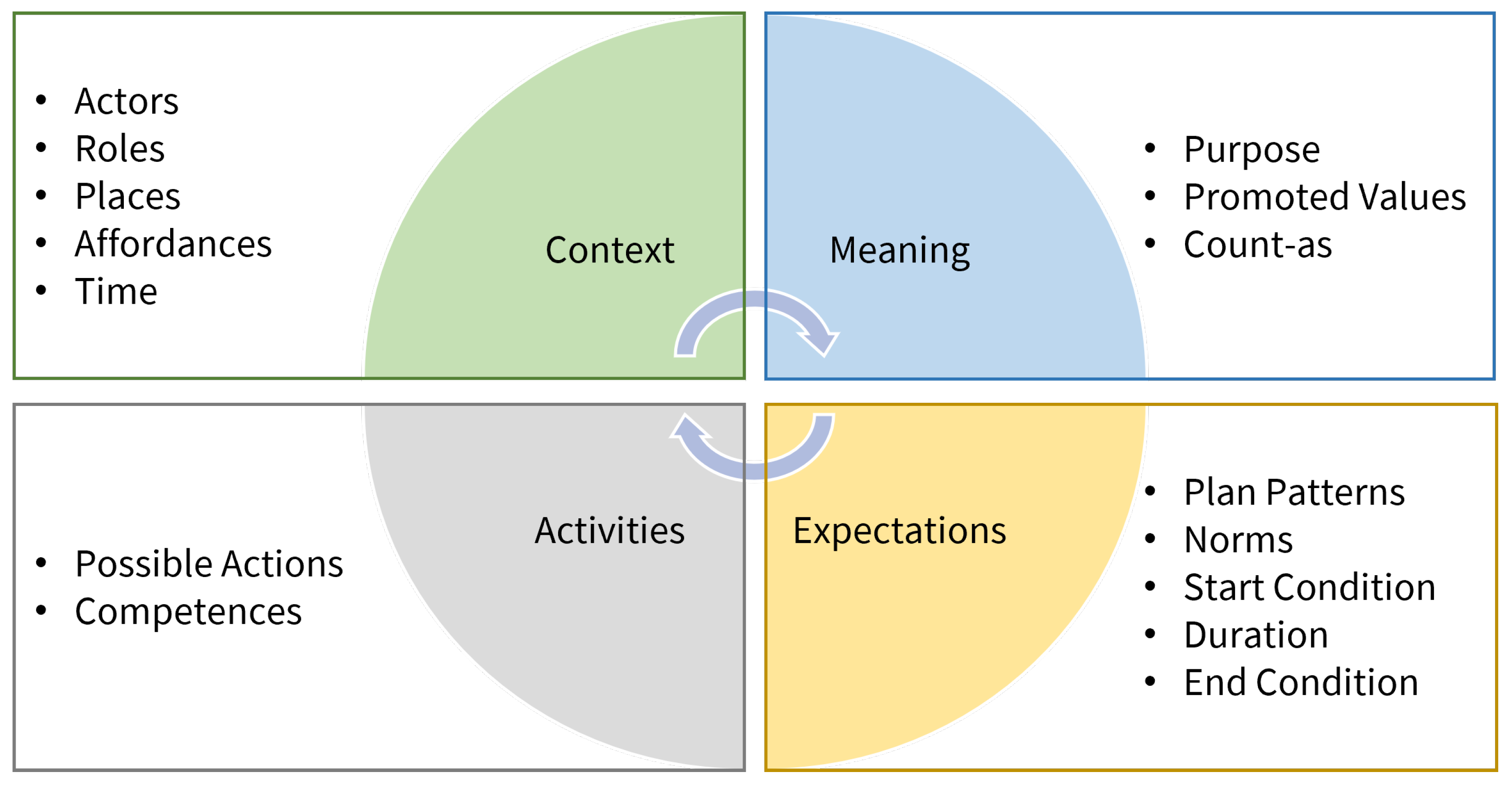
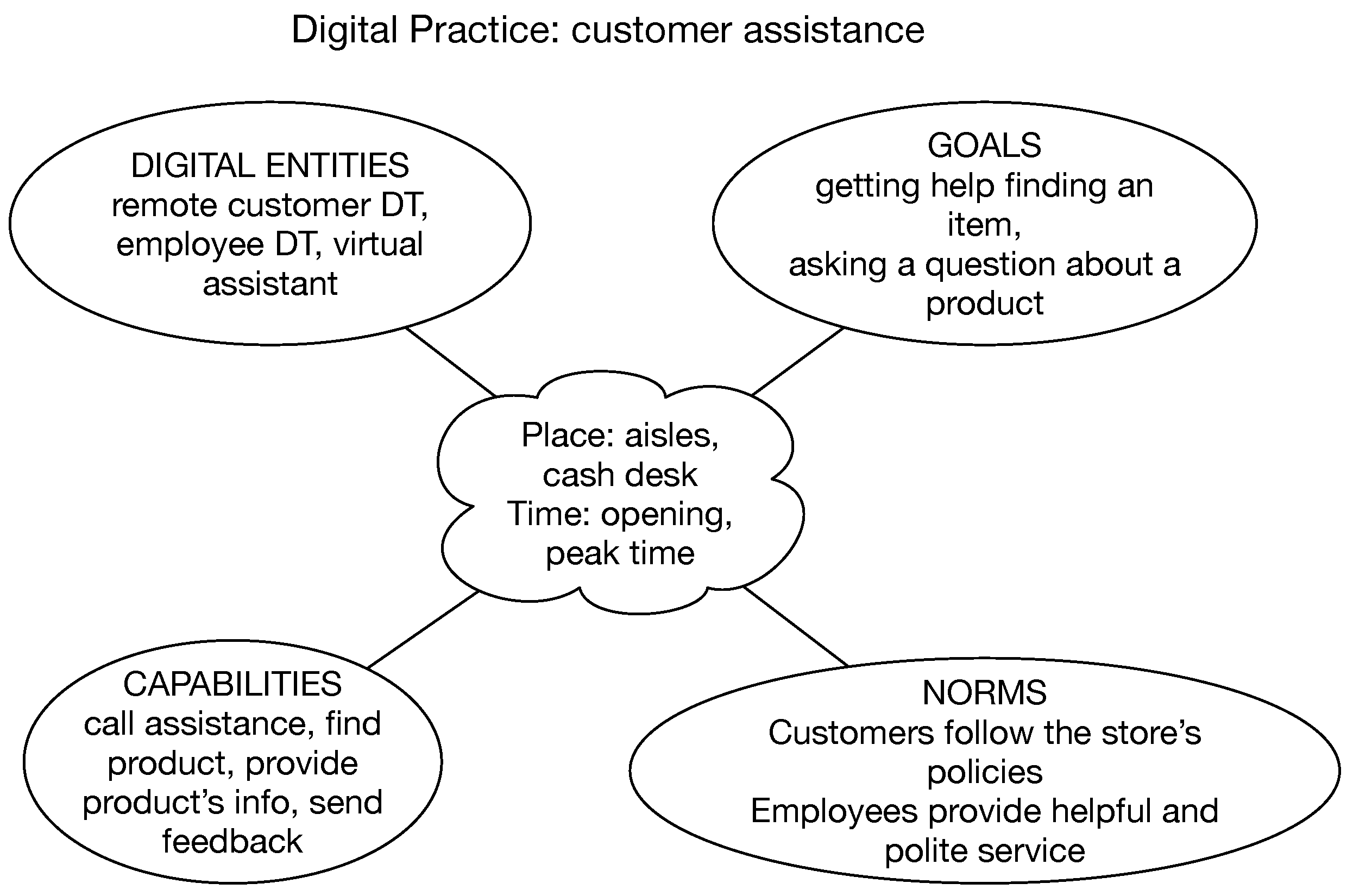
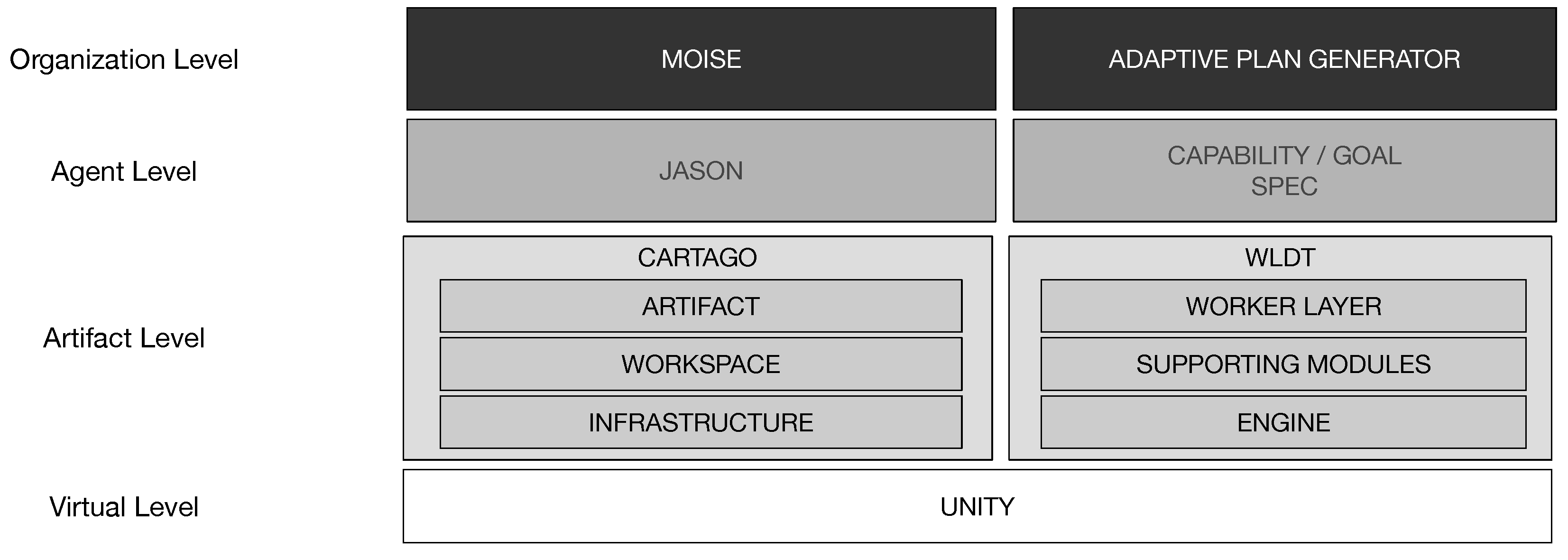
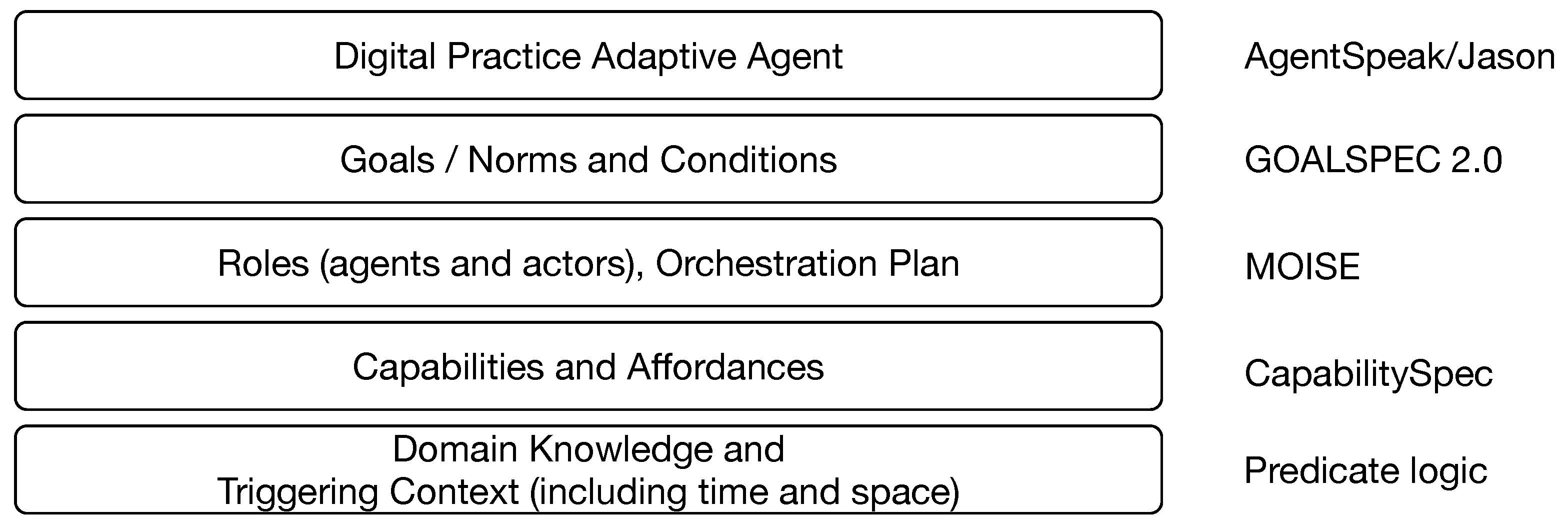
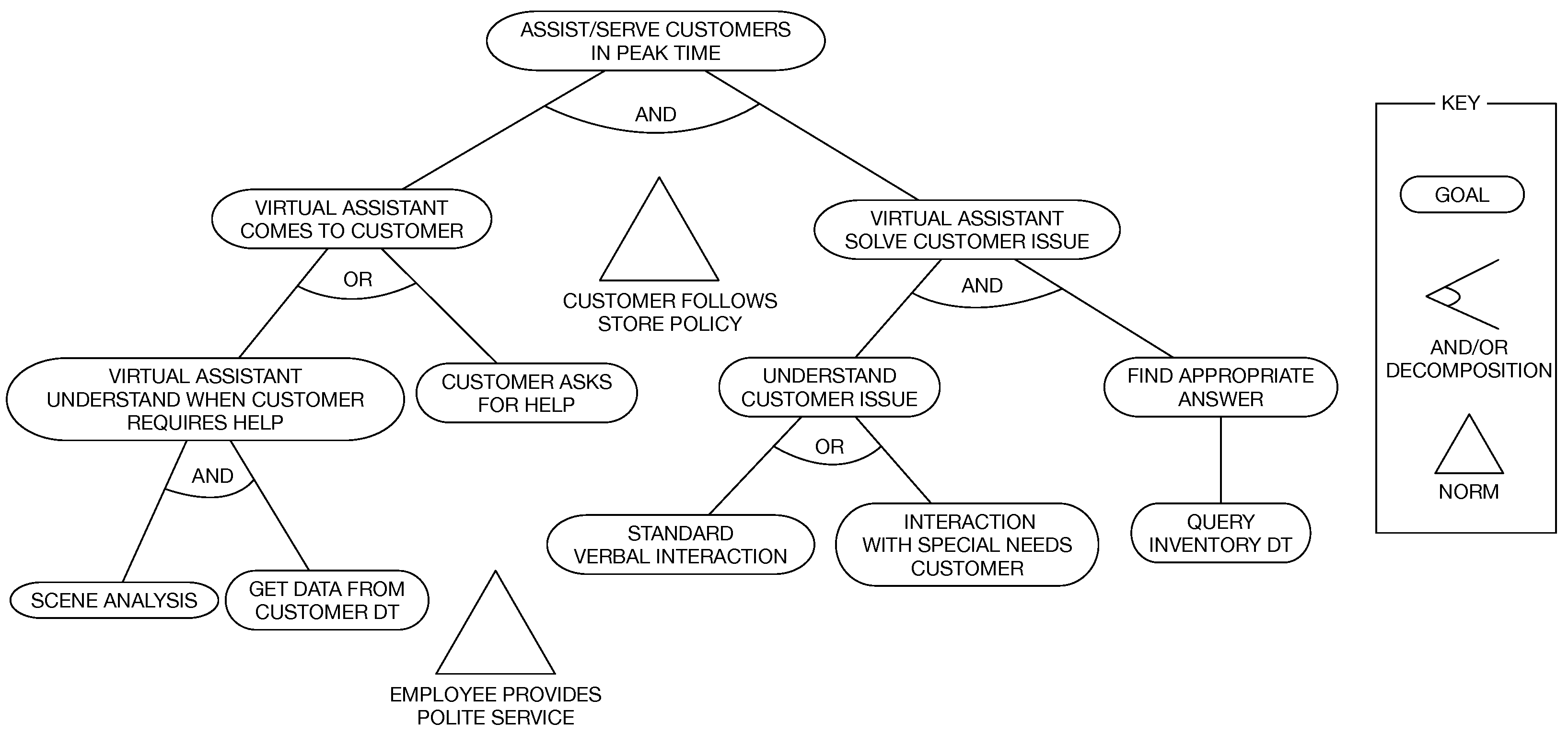

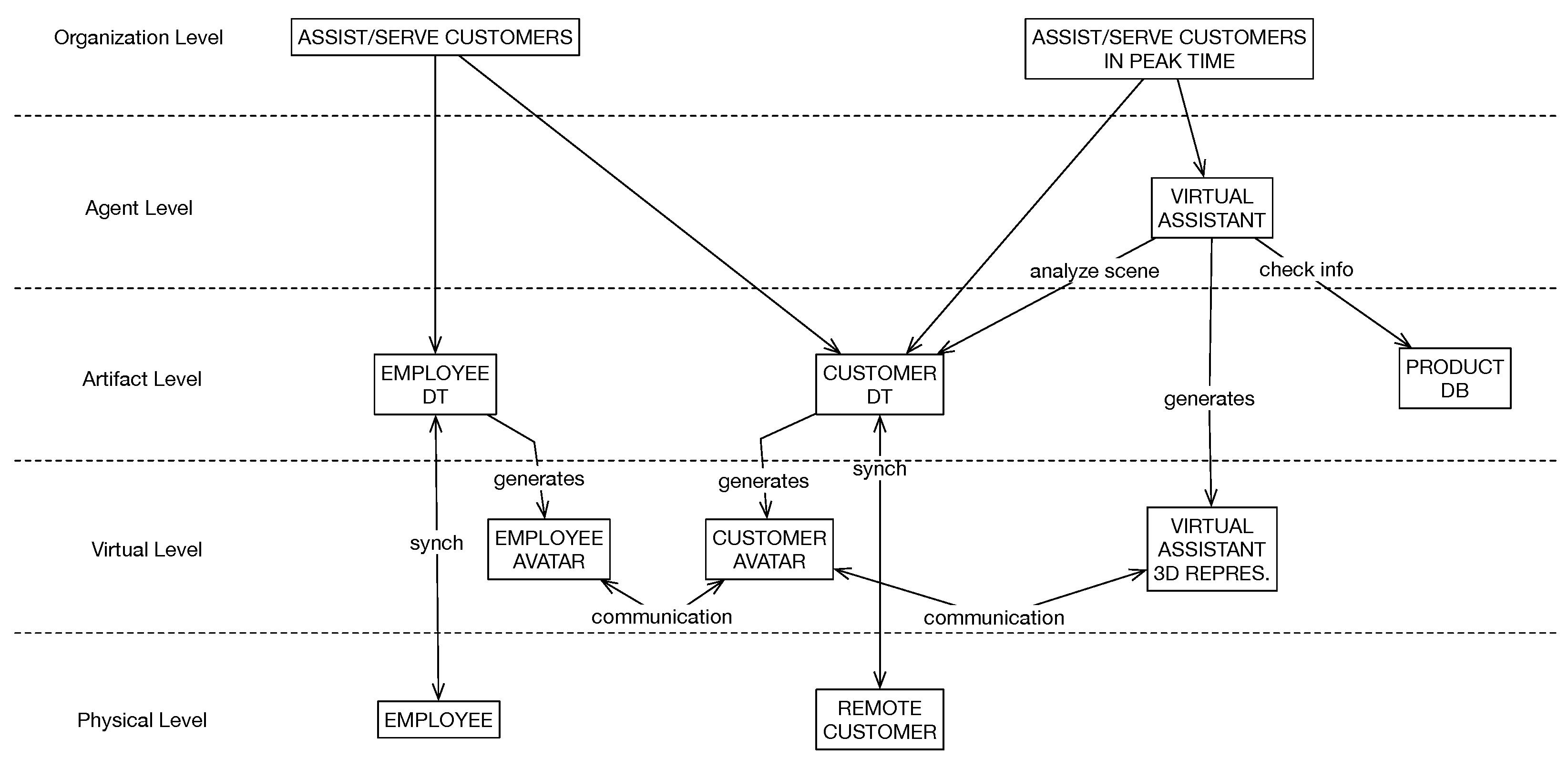
Disclaimer/Publisher’s Note: The statements, opinions and data contained in all publications are solely those of the individual author(s) and contributor(s) and not of MDPI and/or the editor(s). MDPI and/or the editor(s) disclaim responsibility for any injury to people or property resulting from any ideas, methods, instructions or products referred to in the content. |
© 2023 by the authors. Licensee MDPI, Basel, Switzerland. This article is an open access article distributed under the terms and conditions of the Creative Commons Attribution (CC BY) license (https://creativecommons.org/licenses/by/4.0/).
Share and Cite
Sabatucci, L.; Augello, A.; Caggianese, G.; Gallo, L. Envisioning Digital Practices in the Metaverse: A Methodological Perspective. Future Internet 2023, 15, 394. https://doi.org/10.3390/fi15120394
Sabatucci L, Augello A, Caggianese G, Gallo L. Envisioning Digital Practices in the Metaverse: A Methodological Perspective. Future Internet. 2023; 15(12):394. https://doi.org/10.3390/fi15120394
Chicago/Turabian StyleSabatucci, Luca, Agnese Augello, Giuseppe Caggianese, and Luigi Gallo. 2023. "Envisioning Digital Practices in the Metaverse: A Methodological Perspective" Future Internet 15, no. 12: 394. https://doi.org/10.3390/fi15120394
APA StyleSabatucci, L., Augello, A., Caggianese, G., & Gallo, L. (2023). Envisioning Digital Practices in the Metaverse: A Methodological Perspective. Future Internet, 15(12), 394. https://doi.org/10.3390/fi15120394








